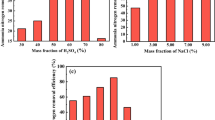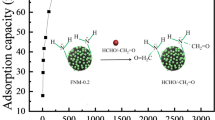Abstract
Two amino-functionalized diatomite (DE) composites modified by 3-aminopropyltriethoxysilane (APTS) or glycine (GLY) (i.e., APTS/DE and GLY/DE) were successfully synthesized via the wet chemical method for the time- and cost-efficient removal of indoor formaldehyde (HCHO). First, the optimal preparation conditions of the two composites were determined, and then their microstructures and morphologies were characterized and analyzed. Batch HCHO adsorption experiments with the two types of amino-modified DE composites were also conducted to compare their adsorption properties. Experimental results indicated that the pseudo-second-order kinetic and Langmuir isotherm models could well describe the adsorption process, and the maximum adsorption capacities of APTS/DE and GLY/DE prepared under optimal conditions at 20°C were 5.83 and 1.14 mg·g−1, respectively. The thermodynamic parameters of the composites indicated that the adsorption process was spontaneous and exothermic. The abundant amine groups grafted on the surface of DE were derived from the Schiff base reaction and were essential for the high-efficient adsorption performance toward HCHO.
Similar content being viewed by others
References
Z.H. Xu, J.G. Yu, and M. Jaroniec, Efficient catalytic removal of formaldehyde at room temperature using AlOOH nanoflakes with deposited Pt, Appl. Catal. B, 163(2015), p. 306.
F. Liu, X.P. Liu, J. Shen, A. Bahi, S.Y. Zhang, L. Wan, and F. Ko, The role of oxygen vacancies on Pt/NaInO2 catalyst in improving formaldehyde oxidation at ambient condition, Chem. Eng. J., 395(2020), art. No. 125131.
X.F. Tang, Y.G. Li, X.M. Huang, Y. D. Xu, H.Q. Zhu, J.G. Wang, and W.J. Shen, MnOx—CeO2 mixed oxide catalysts for complete oxidation of formaldehyde: Effect of preparation method and calcination temperature, Appl. Catal. B, 62(2006), No. 3–4, p. 265.
L.H. Nie, J.G. Yu, X.Y. Li, B. Cheng, G. Liu, and M. Jaroniec, Enhanced performance of NaOH-modified Pt/TiO2 toward room temperature selective oxidation of formaldehyde, Environ. Sci. Technol., 47(2013), No. 6, p. 2777.
X.X. Zhu, W. Chen, K.L. Wu, H.Y. Li, M. Fu, Q.Y. Liu, and X. Zhang, A colorimetric sensor of H2O2 based on Co3O4-montmorillonite nanocomposites with peroxidase activity, New J. Chem., 42(2018), No. 2, p. 1501.
Y. Ma and G.K. Zhang, Sepiolite nanofiber-supported platinum nanoparticle catalysts toward the catalytic oxidation of formaldehyde at ambient temperature: Efficient and stable performance and mechanism, Chem. Eng. J., 288(2016), p. 70.
J.J. Pei, Y.H. Yin, and J.J. Liu, Long-term indoor gas pollutant monitor of new dormitories with natural ventilation, Energy Build., 129(2016), p. 514.
M. Wickenheisser, A. Herbst, R. Tannert, B. Milow, and C. Janiak, Hierarchical MOF-xerogel monolith composites from embedding MIL-100(Fe,Cr) and MIL-101(Cr) in resorcinolformaldehyde xerogels for water adsorption applications, Microporous Mesoporous Mater., 215(2015), p. 143.
X.L. Hu, C.Q. Li, Z.M. Sun, J.Y. Song, and S.L. Zheng, Enhanced photocatalytic removal of indoor formaldehyde by ternary heterogeneous BiOCl/TiO2/sepiolite composite under solar and visible light, Build. Environ., 168(2020), art. No. 106481.
B. Zhu, L.Y. Zhang, M. Li, Y. Yan, X.M. Zhang, and Y.M. Zhu, High-performance of plasma-catalysis hybrid system for toluene removal in air using supported Au nanocatalysts, Chem. Eng. J., 381(2020), art. No. 122599.
Y.C. Huang, H.X. Hu, S.X. Wang, M.S. Balogun, H.B. Ji, and Y.X. Tong, Low concentration nitric acid facilitate rapid electron-hole separation in vacancy-rich bismuth oxyiodide for photo-thermo-synergistic oxidation of formaldehyde, Appl. Catal. B, 218(2017), p. 700.
P. Kowalczyk, P.A. Gauden, M. Wiśniewski, A.P. Terzyk, S. Furmaniak, A. Burian, K. Kaneko, and A.V. Neimark, Atomicscale molecular models of oxidized activated carbon fibre nanoregions: Examining the effects of oxygen functionalities on wet formaldehyde adsorption, Carbon, 165(2020), p. 67.
S. Ashtiani, M. Khoshnamvand, A. Shaliutina-Kolešová, D. Bouša, Z. Sofer, and K. Friess, Co0.5Ni0.5FeCrO4 spinel nanoparticles decorated with UiO-66-based metal-organic frameworks grafted onto GO and O-SWCNT for gas adsorption and water purification, Chemosphere, 255(2020), art. No. 126966.
N. Goyal, P. Gao, Z. Wang, S.W. Cheng, Y.S. Ok, G. Li, and L.Y. Liu, Nanostructured chitosan/molecular sieve-4A an emergent material for the synergistic adsorption of radioactive major pollutants cesium and strontium, J. Hazard. Mater., 392(2020), art. No. 122494.
N.T. Nguyen, T.H. Dao, T.T. Truong, T.M.T. Nguyen, and T.D. Pham, Adsorption characteristic of ciprofloxacin antibiotic onto synthesized alpha alumina nanoparticles with surface modification by polyanion, J. Mol. Liq., 309(2020), art. No. 113150.
Y.Y. Liu, H.W. Jia, C.Q. Li, Z.M. Sun, Y.T. Pan, and S.L. Zheng, Efficient removal of gaseous formaldehyde by aminemodified diatomite: A combined experimental and density functional theory study, Environ. Sci. Pollut. Res., 26(2019), No. 24, p. 25130.
H. Yang, X. Sun, S.X. Liu, J.L. Liu, and X.M. Ren, Low-cost and environmental-friendly kaolinite-intercalated hybrid material showing fast formaldehyde adsorbing behavior, ChemistrySelect, 1(2016), No. 10, p. 2181.
G.F. Wang, Y.F. Xi, C. Lian, Z.M. Sun, and S.L. Zheng, Simultaneous detoxification of polar aflatoxin B1 and weak polar zearalenone from simulated gastrointestinal tract by zwitterionic montmorillonites, J. Hazard. Mater., 364(2019), p. 227.
Y.Y. Liu, H.W. Jia, Z.M. Sun, Y.T. Pan, G.X. Zhang, and S.L. Zheng, High-efficiency removal of gaseous HCHO by amine functionalized natural opoka, Chem. Phys. Lett., 722(2019), p. 32.
G.X. Zhang, Z.M. Sun, Y.W. Duan, R.X. Ma, and S.L. Zheng, Synthesis of nano-TiO2/diatomite composite and its photocatalytic degradation of gaseous formaldehyde, Appl. Surf. Sci., 412(2017), p. 105.
Z.Y. Han, C. Wang, X.H. Zou, T.H. Chen, S.W. Dong, Y. Zhao, J.J. Xie, and H.B. Liu, Diatomite-supported birnessite-type MnO2 catalytic oxidation of formaldehyde: Preparation, performance and mechanism, Appl. Surf. Sci., 502(2020), art. No. 144201.
M.Y. Liu, L. Zheng, G.L. Lin, L.F. Ni, and X.C. Song, Synthesis and photocatalytic activity of BiOCl/diatomite composite photocatalysts: Natural porous diatomite as photocatalyst support and dominant facets regulator, Adv. Powder Technol., 31(2020), No. 1, p. 339.
A.M. Ewlad-Ahmed, M.A. Morris, S.V. Patwardhan, and L.T. Gibson, Removal of formaldehyde from air using functionalized silica supports, Environ. Sci. Technol., 46(2012), No. 24, p. 13354.
K. Vellingiri, Y.X. Deng, K.H. Kim, J.J. Jiang, T. Kim, J. Shang, W.S. Ahn, D. Kukkar, and D.W. Boukhvalov, Aminefunctionalized metal-organic frameworks and covalent organic polymers as potential sorbents for removal of formaldehyde in aqueous phase: Experimental versus theoretical study, ACS Appl. Mater. Interfaces, 11(2019), No. 1, p. 1426.
A. Nomura and C.W. Jones, Amine-functionalized porous silicas as adsorbents for aldehyde abatement, ACS Appl. Mater. Interfaces, 5(2013), No. 12, p. 5569.
E. Vilarrasa-García, J.A. Cecilia, M. Bastos-Neto, C.L. Cavalcante, D.C.S. Azevedo, and E. Rodríguez-Castellón, Microwave-assisted nitric acid treatment of sepiolite and function-alization with polyethylenimine applied to CO2 capture and CO2/N2 separation, Appl. Surf. Sci., 410(2017), p. 315.
J. Cheng, X.J. Gu, P.L. Liu, H. Zhang, L.L. Ma, and H.Q. Su, Achieving efficient room-temperature catalytic H2 evolution from formic acid through atomically controlling the chemical environment of bimetallic nanoparticles immobilized by isoreticular amine-functionalized metal-organic frameworks, Appl. Catal. B, 218(2017), p. 460.
S.M. Mirabedini, M. Esfandeh, R.R. Farnood, and P. Rajabi, Amino-silane surface modification of urea-formaldehyde microcapsules containing linseed oil for improved epoxy matrix compatibility. Part I: Optimizing silane treatment conditions, Prog. Org. Coat., 136(2019), art. No. 105242.
Y.F. Wu, Y.W. Sun, J. Xiao, X. Wang, and Z. Li, Glycine-modified HKUST-1 with simultaneously enhanced moisture stability and improved adsorption for light hydrocarbons separation, ACS Sustainable Chem. Eng., 7(2019), No. 1, p. 1557.
F. Li, J.F. Ye, L.M. Yang, C.H. Deng, Q. Tian, and B. Yang, Surface modification of ultrafiltration membranes by grafting glycine-functionalized PVA based on polydopamine coatings, Appl. Surf. Sci., 345(2015), p. 301.
X.Q. Zhu, B. Guo, J. Fang, T.S. Zhai, Y.N. Wang, G.W. Li, J.Q. Zhang, Z.X. Wei, S. Duhm, X. Guo, M.J. Zhang, and Y.F. Li, Surface modification of ZnO electron transport layers with glycine for efficient inverted non-fullerene polymer solar cells, Org. Electron., 70(2019), p. 25.
F. Yuan, Z.M. Sun, C.Q. Li, Y. Tan, X.W. Zhang, and S.L. Zheng, Multi-component design and in situ synthesis of visible-light-driven SnO2/g-C3N4/diatomite composite for high-efficient photoreduction of Cr(VI) with the aid of citric acid, J. Hazard. Mater., 396(2020), art. No. 122694.
Z.M. Sun, F. Yuan, X.C. Zhang, R. Zhu, X.Y. Shen, B.Y. Sun, and B. Wang, Design and synthesis of organic rectorite-based composite nanofiber membrane with enhanced adsorption performance for bisphenol A, Environ. Sci. Pollut. Res., 26(2019), No. 28, p. 28860.
X.Y. Wang, J.M. Sun, Y.F. Zhang, and Y.M. Zhang, Study on the correlation between pore morphology of porous calcium silicate and high-capacity formaldehyde adsorption, Environ. Technol., 42(2021), No. 13, p. 2021.
K. Vikrant, M. Cho, A. Khan, K.H. Kim, W.S. Ahn, and E.E. Kwon, Adsorption properties of advanced functional materials against gaseous formaldehyde, Environ. Res., 178(2019), art. No. 108672.
S.C. Hu, Y.C. Chen, X.Z. Lin, A. Shiue, P.H. Huang, Y.C. Chen, S.M. Chang, C.H. Tseng, and B. Zhou, Characterization and adsorption capacity of potassium permanganate used to modify activated carbon filter media for indoor formaldehyde removal, Environ. Sci. Pollut. Res., 25(2018), No. 28, p. 28525.
C.Q. Su, K.K. Liu, J.C. Zhu, H.Y. Chen, H.L. Li, Z. Zeng, and L.Q. Li, Adsorption effect of nitrogen, sulfur or phosphorus surface functional group on formaldehyde at ambient temperature: Experiments associated with calculations, Chem. Eng. J., 393(2020), art. No. 124729.
G. de Falco, M. Barczak, F. Montagnaro, and T.J. Bandosz, A new generation of surface active carbon textiles as reactive adsorbents of indoor formaldehyde, ACS Appl. Mater. Interfaces, 10(2018), No. 9, p. 8066.
W.J. Yuan, S.P. Zhang, Y.Y. Wu, X.M. Huang, F.H. Tian, S.W. Liu, and C.H. Li, Enhancing the room-temperature catalytic degradation of formaldehyde through constructing surface lewis pairs on carbon-based catalyst, Appl. Catal. B, 272(2020), art. No. 118992.
Acknowledgements
This work was financially supported by the National Training Program of Innovation and Entrepreneurship for Undergraduates (No. C201903678), the Fundamental Research Funds for the Central Universities (2020YJSHH02), Fok Ying Tung Education Foundation, China (No. 171042), and the Yue Qi Young Scholar Project of the China University of Mining and Technology (Beijing) (No. 2017 QN12).
Author information
Authors and Affiliations
Corresponding authors
Additional information
Conflict of Interest
The authors declare no potential conflict of interest.
Rights and permissions
About this article
Cite this article
Di, Y., Yuan, F., Ning, X. et al. Functionalization of diatomite with glycine and amino silane for formaldehyde removal. Int J Miner Metall Mater 29, 356–367 (2022). https://doi.org/10.1007/s12613-020-2245-3
Received:
Revised:
Accepted:
Published:
Issue Date:
DOI: https://doi.org/10.1007/s12613-020-2245-3




